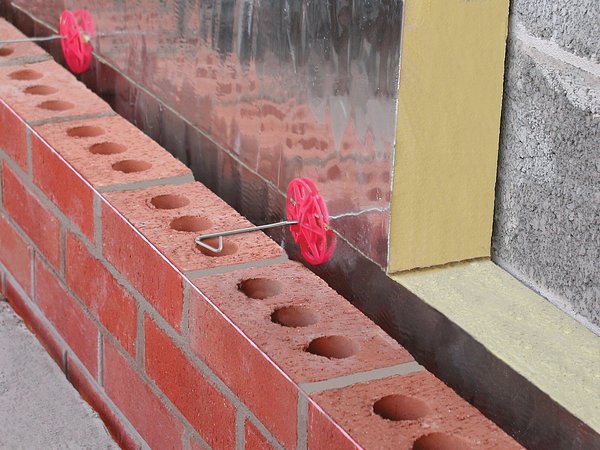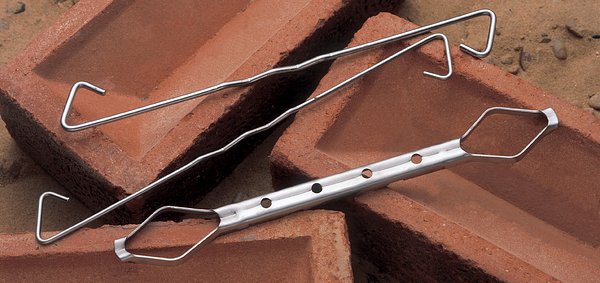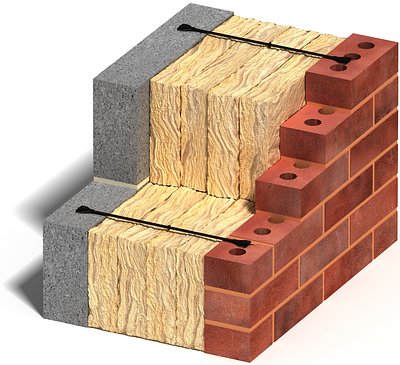What is a wall tie?
Wall ties, sometimes called ‘brick ties’, are used in buildings with cavity walls. They are used to join the two leaves of a cavity wall together, allowing the two parts to act as a homogeneous unit. Hidden from view after construction, wall ties play a vital role in ensuring the stability of a building.

Insufficient or poorly installed wall ties can lead to severe structural issues, including damp penetration, masonry cracks or even the collapse of the outer masonry leaf. Wall ties are manufactured from corrosion and fire resistant materials and include a drip formation to prevent the passage of water to the inner leaf.
Wall tie design
Most buildings built since the 1920’s feature cavity walls. Over the years, wall tie shapes have evolved tremendously and various materials have been used which are now obsolete e.g. plastic, galvanised steel. Prior to 1978, wall ties were usually manufactured from galvanised mild steel. These ties were expected to last the lifetime of the building, but it has since been recognised that these wall ties can corrode after only 15-20 years.

Corroded Mild Steel Wall Tie
These days, wall ties are predominantly manufactured from stainless steel which is now readily available commercially and withstands corrosion from water and cement without requiring additional protection. Modern stainless steel wall ties offer a maintenance-free life and are value-engineered to reduce material content.

Stainless Steel Wall Ties
Some composite materials are also used, such as Ancon’s Teplo range of ties which are made from pultruded basalt fibres set in a resin matrix, which are ideal in ultra-low energy construction where the prevention of heat loss via ‘thermal bridging’ is particularly important.

Teplo-BF Basalt Fibre Cavity Wall Tie
Wall tie installation

Wall Tie Embedment
In standard brick-to-block construction, wall ties are built into the leaves during construction. To ensure wall ties are effective at tying the leaves together they should be pressed down in and then surrounded by fresh mortar and should never be pushed into a pre-built joint. They should be installed with a slight fall to the outer leaf, not towards the inner leaf as this could provide a path for moisture to cross the cavity. The drip part of the tie should point downward and be positioned near the centre of the open cavity.
In other types of cavity wall construction, such as thin-joint blockwork and timber or steel frames, wall ties are typically installed after the inner leaf has been constructed and during the build of the outer leaf of masonry.
Wall tie length and wall tie spacing
Ties must be long enough to span the cavity and provide the minimum embedment in the mortar at both ends, typically 62-75mm. For example, a 200mm long wall tie is suitable for cavities from 50-75mm.
Cavities are increasingly wider to accommodate thicker insulation depths, as energy efficiency standards improve. Standard wall ties are now available to suit cavity widths from 50mm to 450mm.
The minimum density of cavity wall ties (as defined in Eurocode 6) is 2.5 ties per square metre. Typically they are installed at 900mm horizontal x 450mm vertical spacing and should be staggered across the wall area to provide an even distribution. Additional ties should be used at a rate of one per 300mm height around openings and unbonded edges (although blockwork coursing usually means that they are installed at 225mm vertical spacing). Further information about the position and density of cavity wall ties may be found in PD 6697:2010.
Standard spacing for cavity brickwork 900mm x 450mm centres in a staggered pattern (2.5 ties per square metre)
Wall tie selection
The selection of wall ties depends on many factors. These include the type of masonry to be tied, the cavity width, the type and height of the building and its geographical location.
All factors governing the correct use of wall ties in any given situation are covered by several Eurocodes and Building Regulations, which should be referred and adhered to. To complement the Building Regulations and Eurocodes, in the UK we have an additional Published Document (PD 6697:2010) which aids in the selection of wall ties based upon geographic and topographic factors. This means that, in the majority of cases, cavity wall ties may be specified without the involvement of a structural engineer.
Tie Types 1 to 4 are used in masonry-to-masonry applications and Tie Types 5-7 in masonry-to-timber applications.
Masonry-to-Masonry Wall Tie Types to PD 6697: 2010
| Type | Application | Density | Maximum Building Height | Geographical Location |
|---|---|---|---|---|
| Type 1 e.g. ST1, SD1, Teplo-BF1 |
Heavy duty tie suitable for most building sizes and types. Not very flexible and not recommended for applications where there is expected to be excessive differential movement between leaves | 2.5 ties/m² 3-4 ties/m² at unbonded edges |
Any height | Suitable for most sites. However, for relatively tall or unusually shaped buildings in vulnerable areas, the tie provision should be calculated |
| Type 2 e.g. RT2, Teplo-BF2 |
General purpose tie for domestic and small commercial buildings. | As Type 1 | 15m | Suitable for flat sites where the basic wind speed is up to 31m/s and altitude is not more than 150m above sea level |
| Type 2 ties are suitable for use outside the parameters stated e.g. sites over 150m above sea level, buildings exceeding 15 metres etc, if shown to be adequate by calculation. Contact Ancon for more information. | ||||
| Type 3 e.g. RD3, Teplo-BF3 |
Basic wall tie generally as Type 2 above | As Type 1 | 15m | Suitable for flat sites where the basic wind speed is up to 27m/s and altitude is not more than 150m above sea level |
| Type 4 e.g. HRT4, Teplo-BF4 |
Light duty wall tie suitable for box-form domestic dwellings with leaves of similar thickness | As Type 1 | 10m | Suitable for flat sites in towns and cities where the basic wind speed does not exceed 27m/s and altitude is not more than 150m above sea level |
Note: Refer to PD 6697: 2010 and BS EN 1991-1-4: 2005 for complete information.
Masonry-to-Timber Tie Types to BS 5268-6.1: 1996
| Type | Application | Density | Maximum Building Height | Geographical Location |
|---|---|---|---|---|
| Type 5 e.g. Teplo-L-5 |
Timber frame tie suitable for domestic houses and industrial/ commercial developments of up to three storeys | 4.4 ties/m² 3-4 ties/m² at unbonded |
15m | Suitable for flat sites in towns and cities where the basic wind speed does not exceed 25m/s and altitude is not more |
| Type 6 e.g. STF6, TIM6, Teplo-L-6 |
As Type 5 but suitable for developments of up to four storeys | As Type 5 | 15m | Suitable for flat sites in towns and cities where the basic wind speed does not exceed 25m/s and altitude is not more than 150m above sea level |
| Type 7 e.g. TFMT7, Teplo-L-7 |
As Type 5 but suitable for developments of between five and seven storeys, being designed to accommodate the increased vertical | Calculated for actual performance required for each site location | 18m | Calculated for actual performance required for each site location |
Note: Refer to BS 5268-6.1: 1996 and BS 6399-2: 1997 for complete information.
The Ancon range includes ties for all forms of cavity construction, including the TJ2 tie for thin joint blocks and the CCB range for cellular clay blockwork; three Type 6 timber frame ties; frame cramps for fixing to concrete, steel or masonry.
Use our Cavity Wall Tie Product Selector tool or contact a member of the technical team to aid wall tie selection.
Latest News
Leviat Introduces A1-Rated Non-combustible Insulation Retaining Clip for High-Rise Projects
Leviat, global leader in engineered construction solutions, has launched the Ancon A1-ST1 insulation retaining clip, a new non-combustible, A1-rated solution specifically designed to fit the Ancon ST1 heavy duty wall tie widely used in high-rise buildings.
Leviat Sponsors Concrete Society Awards 2025
Leviat is delighted to announce its continued sponsorship of the popular Concrete Society Awards for 2025, taking place on Wednesday 12th November, at London’s Royal Lancaster Hotel.


1 comment
Please leave a comment using the form below
Wall Construction Davis, CA
Thank you for sharing this informative article about wall construction. I hope there are a lot of mason contractors who could read this and be guided accordingly.